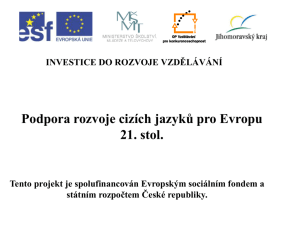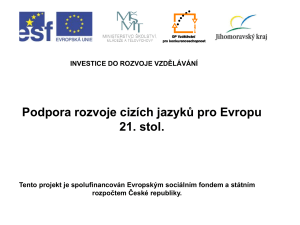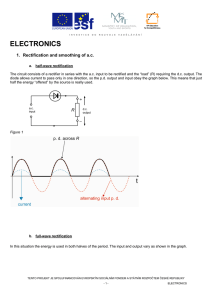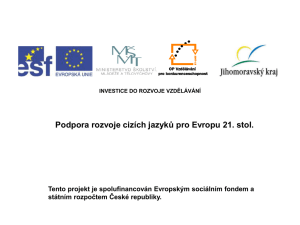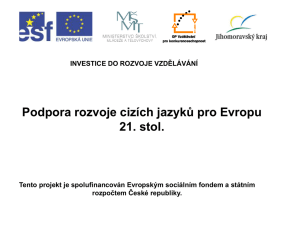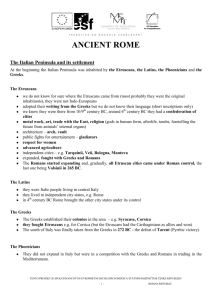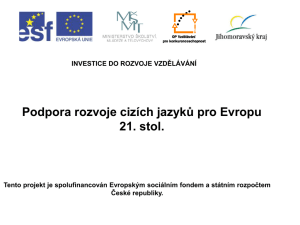ELECTRIC CHARGE AND ELECTRIC FIELD
advertisement
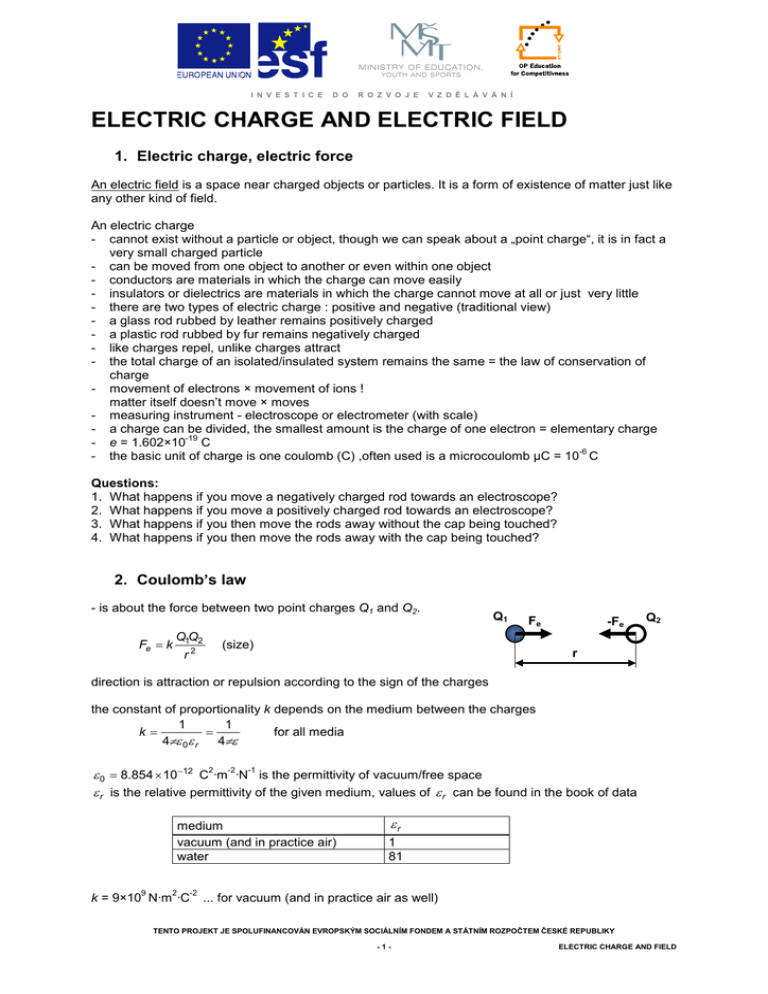
I N V E S T I C E D O R O Z V O J E V Z D Ě L Á V Á N Í ELECTRIC CHARGE AND ELECTRIC FIELD 1. Electric charge, electric force An electric field is a space near charged objects or particles. It is a form of existence of matter just like any other kind of field. An electric charge - cannot exist without a particle or object, though we can speak about a „point charge“, it is in fact a very small charged particle - can be moved from one object to another or even within one object - conductors are materials in which the charge can move easily - insulators or dielectrics are materials in which the charge cannot move at all or just very little - there are two types of electric charge : positive and negative (traditional view) - a glass rod rubbed by leather remains positively charged - a plastic rod rubbed by fur remains negatively charged - like charges repel, unlike charges attract - the total charge of an isolated/insulated system remains the same = the law of conservation of charge - movement of electrons × movement of ions ! matter itself doesn’t move × moves - measuring instrument - electroscope or electrometer (with scale) - a charge can be divided, the smallest amount is the charge of one electron = elementary charge -19 - e = 1.602×10 C -6 - the basic unit of charge is one coulomb (C) ,often used is a microcoulomb µC = 10 C Questions: 1. What happens if 2. What happens if 3. What happens if 4. What happens if you move a negatively charged rod towards an electroscope? you move a positively charged rod towards an electroscope? you then move the rods away without the cap being touched? you then move the rods away with the cap being touched? 2. Coulomb’s law - is about the force between two point charges Q1 and Q2. Fe = k Q1Q2 r2 Q1 Fe (size) -Fe Q2 r direction is attraction or repulsion according to the sign of the charges the constant of proportionality k depends on the medium between the charges 1 1 k= = for all media 4πε 0ε r 4πε ε 0 = 8.854 × 10 −12 C2·m-2·N-1 is the permittivity of vacuum/free space ε r is the relative permittivity of the given medium, values of ε r can be found in the book of data medium vacuum (and in practice air) water 9 2 k = 9×10 N·m ·C -2 εr 1 81 ... for vacuum (and in practice air as well) TENTO PROJEKT JE SPOLUFINANCOVÁN EVROPSKÝM SOCIÁLNÍM FONDEM A STÁTNÍM ROZPOČTEM ČESKÉ REPUBLIKY -1- ELECTRIC CHARGE AND FIELD I N V E S T I C E D O R O Z V O J E V Z D Ě L Á V Á N Í Questions: 5. Rewrite Coulomb’s law with the complete equation for “k”. Explain all the quantities, sketch the figure. 6. Two small spheres carry charges of -2 nC and 8 nC and they are 20 cm apart in the air. Calculate a) the force between them b) the force between the same charges when the distance is doubled c) the force between the charges when we pour oil of relative permittivity 6 between the charges d) the force between the spheres when we put them in contact and then move apart to the distance of 20 cm. 7. How many elementary charges represent 1 µC? 8. If the force between two charged bodies is F, then doubling the charges carried by both bodies and doubling their distance apart changes the force to F F a) b) c) F d) 2F e) 4F 4 2 3. Models of electric field electric field lines = according to the direction of force that would be acting on a .............. charge (state the polarity of the desks and point charges) types of electric field uniform central .......... source ........... source combined electric fields of two charges (finish the figures of the fields around the charges, state the polarity of the charges) TENTO PROJEKT JE SPOLUFINANCOVÁN EVROPSKÝM SOCIÁLNÍM FONDEM A STÁTNÍM ROZPOČTEM ČESKÉ REPUBLIKY -2- ELECTRIC CHARGE AND FIELD I N V E S T I C E D O R O Z V O J E V Z D Ě L Á V Á N Í → 4. Electric field strength E is a vector quantity used to determine the electric field → → E F E= e q Fe + → Fe … electric force acting at a certain point of the el. field on a test charge q q … test charge ( ) → −1 −1 E = N ⋅ C or V ⋅ m → Qq 1 Q F for the size of E : E = e = k 2 ⋅ = k 2 q q r r The direction of the electric field strength at a point varies according to the direction of the electric force which would be acting on a positive test charge at this point. It is also at a tangent to the electric field lines which represent a theoretical trajectory of a positive test charge in this field. Questions: 9. Sketch the electric field strength vectors from the points in the following figures TENTO PROJEKT JE SPOLUFINANCOVÁN EVROPSKÝM SOCIÁLNÍM FONDEM A STÁTNÍM ROZPOČTEM ČESKÉ REPUBLIKY -3- ELECTRIC CHARGE AND FIELD I N V E S T I C E D O R O Z V O J E V Z D Ě L Á V Á N Í 5. Electric potential ϕ is a scalar quantity used to describe the electric field ϕA = W0 A q ϕ A … electric potential at a point A in the electric field W0 A … work done by electric forces to move q from A to zero level of el. potential (Earth, infinity) q … test charge [ϕ ] = J ⋅ C −1 = V Electric potential at some point in the el. field equals 1V when electric work of 1J is done to move the charge of +1C from this point to zero level of the el. potential equipotentials = surfaces with the same value of el. potential uniform el. field central el. field - + A x d ϕA = W0 A q ϕA = W0 A q ϕ A = Ex ϕA = k Q r Questions: 10. Two point charges Q1 = 5 nC and Q2 = -8 nC are placed in a vacuum. Calculate the potential and state the field strength at a point P that is 0.5 m from the first charge and 120 cm from the second one as shown on the figures. a) b) c) Q1 P Q2 Q2 Q1 P P Q2 Q1 TENTO PROJEKT JE SPOLUFINANCOVÁN EVROPSKÝM SOCIÁLNÍM FONDEM A STÁTNÍM ROZPOČTEM ČESKÉ REPUBLIKY -4- ELECTRIC CHARGE AND FIELD I N V E S T I C E D O R O Z V O J E V Z D Ě L Á V Á N Í 11. Calculate potential and field strength in similar situations a), b), and c) just for both charges having positive values and placed in a medium of relative permittivity 30. L5/1-30 6. Work done in electric field in any type of field - equation ∫ W = Fds varies according to the type of field ( F ≠ const in the central el. field !!!) uniform electric field W = Fe d cos α = qEd cos α W… work done to move q from A to B E … value of electric field strength d … distance between A and B α … angle between the force on q and the displacement W ⟩ 0 when done by the forces of the field W ⟨0 when done by outer force against the field voltage (potential difference) between two points A and B is the work done to move the charge of +1C from A to B = difference in the potentials of the points = potential difference WAB = ϕB − ϕ A general eqn for any field q See figure for equipotentials of the uniform el. field : U AB = What is the relation between the voltage between the plates and the electric field strength? U = ϕ + − ϕ − = ϕ + − 0 = W+ 0 = [E ] = U = V ⋅ m −1 d Fe d Eqd = = Ed q q another unit of .......................... Questions: -1 12. A charge of 20 µC is moved in the uniform electric field of strength 20 V·m by 50 cm. Calculate a) voltage between the plates when the distance between them is 120 cm b) work done when the charge is moved in the direction of the field lines c) work done when the charge is moved against the direction of the field lines d) work done when the charge is moved perpendicularly to the field lines e) which of the answers a)-d) will change when the charge is negative and what will be the new results A 13. The point source creates a central electric field as shown. To which of the points A, B, C and D should be moved the test charge along the given trajectories from P to do B P a) maximum work b) minimum work C D TENTO PROJEKT JE SPOLUFINANCOVÁN EVROPSKÝM SOCIÁLNÍM FONDEM A STÁTNÍM ROZPOČTEM ČESKÉ REPUBLIKY -5- ELECTRIC CHARGE AND FIELD I N V E S T I C E D O R O Z V O J E V Z D Ě L Á V Á N Í 14. The first body has a potential of 100 V and the second one -20 V. What is the value of the charge moved from the first one to the second one when the work done is 6 mJ? -1 15. A uniform electric field between two parallel plates 20 cm apart has the value of 400 N·C . Calculate: a) voltage between the plates b) the force that would be acting on a charge of -2 nC placed in the field c) what would be the electric field strength when the distance between the plates changes to 30 cm? 7. Conductor and insulator in electric field, distribution of charge Conductor When we place a conductor into the electric field free electrons will move according to the field and different parts of the object become oppositely charged though the total charge of the object remains zero. The effect is called electrostatic induction. When we earth the object as on the figure it can suck free electrons from the Earth and if we then disconnect it, we can obtain a negatively charged object. When we earth the opposite part of the object, we of course get a positively charged object. Distribution of charge on the conducting object Q charge density A [σ ] = C ⋅ m −2 σ= explain with the help of experiments seen that the charge is distributed over the outer surface only with maximum σ on convex regions – peaks, tips TENTO PROJEKT JE SPOLUFINANCOVÁN EVROPSKÝM SOCIÁLNÍM FONDEM A STÁTNÍM ROZPOČTEM ČESKÉ REPUBLIKY -6- ELECTRIC CHARGE AND FIELD I N V E S T I C E D O R O Z V O J E V Z D Ě L Á V Á N Í Insulator Insulator or dielectrics is a substance without free charged particles. When we place it into the outer electric field its molecules can turn (e.g. in polar liquids like water) or the electron shells can be deflected so that an opposite charge is obtained as on the figure (e.g. bits of paper). The inner electric field is therefore pointed against the outer one and it varies according to the type of dielectrics. The effect is called polarisation of dielectrics εr = E outer e.f .s. = = relative permittivity of the medium E − Ei resultant e.f .s. Questions: 16. Can we obtain two pieces of oppositely charged material when we place in the outer electric field a) a piece of metal b) a piece of polystyrene? Explain. 17. What will you observe when a piece of metal is placed into the electric field? Is there any attraction or repulsion? 18. What if you do the same with a piece of insulator? Is it the same or not? What is the difference? 19. Estimate the value of resultant electric field strength inside a conductor or insulator of relative permittivity 4 and finish the graphs conductor insulator E E distance distance TENTO PROJEKT JE SPOLUFINANCOVÁN EVROPSKÝM SOCIÁLNÍM FONDEM A STÁTNÍM ROZPOČTEM ČESKÉ REPUBLIKY -7- ELECTRIC CHARGE AND FIELD I N V E S T I C E D O R O Z V O J E V Z D Ě L Á V Á N Í 8. Uses of electrostatics Smoke cleaning http://www.explainthatstuff.com/electrostaticsmokeprecipitators.html principle: Copier http://home.howstuffworks.com/photocopier.htm http://en.wikipedia.org/wiki/Photocopier http://projektysipvz.gytool.cz/ProjektySIPVZ/Default.aspx?uid=244 parts: principle: analogue × digital: TENTO PROJEKT JE SPOLUFINANCOVÁN EVROPSKÝM SOCIÁLNÍM FONDEM A STÁTNÍM ROZPOČTEM ČESKÉ REPUBLIKY -8- ELECTRIC CHARGE AND FIELD I N V E S T I C E D O R O Z V O J E V Z D Ě L Á V Á N Í 9. Capacitance (C) is the ability of a conductor to store a charge. Q ∆ϕ C ... capacitance of the conductor Q ... charge supplied to the conductor ∆ϕ ... change of its potential C= [C ] = C ⋅ V −1 = F (farad) C = 4πε 0R capacitance of a conducting sphere -12 capacitance of isolated objects is very small, e.g. for R =10 cm, C =11 pF =11×10 F Question: 20. State the radius of a sphere having the capacitance of 1 F. 10. Capacitors are special components used to store charge. They consist of two parallel plates separated by an insulator. C = ε 0ε r A ... d ... ε r ... C= A d common area of the plates distance ....................... relative permittivity of .......................... Q U http://www.ngsir.netfirms.com/englishhtm/RC_dc.htm Types of capacitors - according to the medium between the plates air variable - ∆A ⇒ ∆C mica ceramic – big capacitance related to size electrolytic – can be used in d.c.circuits in one polarity waxed paper plastic TENTO PROJEKT JE SPOLUFINANCOVÁN EVROPSKÝM SOCIÁLNÍM FONDEM A STÁTNÍM ROZPOČTEM ČESKÉ REPUBLIKY -9- ELECTRIC CHARGE AND FIELD I N V E S T I C E D O R O Z V O J E V Z D Ě L Á V Á N Í What types of capacitors are on the figures below? TENTO PROJEKT JE SPOLUFINANCOVÁN EVROPSKÝM SOCIÁLNÍM FONDEM A STÁTNÍM ROZPOČTEM ČESKÉ REPUBLIKY - 10 - ELECTRIC CHARGE AND FIELD I N V E S T I C E D O R O Z V O J E V Z D Ě L Á V Á N Í Capacitor networks Capacitors in parallel always have a bigger total capacitance than the component capacitors; we are in fact making a capacitor with a bigger plate area. C = C1 + C2 + ... + Cn Capacitors in series have always smaller total capacitance than any of the component capacitors. The total charge stored is the same as the charge on any of the capacitors. The voltage is divided as if there are resistors. 1 1 1 1 = + + ... + C C1 C Cn Questions: 21. Three capacitors of capacitance 1 nF, 2 nF and 4 nF are connected to a source of 10 V. Calculate the charge and voltage on each when they are connected: a) in parallel b) in series c) 1 nF capacitor connected in series to the parallel connection of the other two d) 4 nF capacitor connected in parallel to the series connection of the other two 22. Three capacitors of capacitances 1 nF, 2 nF and 4 nF are connected a) in series b) in parallel Discuss where will be the biggest amount of the total charge and voltage in each of the connections a) and b) Energy of a charged capacitor During the charging of a capacitor the charge moves to the plates due to the work done by electric forces. That is why the capacitor gains the same value of energy that can be used during the discharge e.g. to light the bulb of a “forever flash”. The energy is stored in the polarized dielectrics, in the electric field between the plates. The equation shows that assuming constant value of capacitance, the charge stored is directly proportional to the voltage between the plates: C= Q W As we define the voltage U = , we can get the equation for work and hence energy U Q W = ∫ UdQ ∫ W = UdQ = This could be easily calculated as the area under the U – Q graph below. 1 1 1 Q2 UQ = U 2C = 2 2 2 C U Q TENTO PROJEKT JE SPOLUFINANCOVÁN EVROPSKÝM SOCIÁLNÍM FONDEM A STÁTNÍM ROZPOČTEM ČESKÉ REPUBLIKY - 11 - ELECTRIC CHARGE AND FIELD I N V E S T I C E D O R O Z V O J E V Z D Ě L Á V Á N Í Questions: 23. A 10 µF capacitor is connected to a 50 V supply. Calculate the charge and energy stored on the capacitor. L5/41-57 Answers: 6. a) 3.6 µN attraction b) 0.9 µN c) 0.6 µN d) 2.025 µN repulsion 12 7. 6.24×10 e 8. c) -1 -1 -1 10. a) 30 V; 230 N·C b) 30 V; 130 N·C c) 30 V; 187 N·C -1 -1 -1 11. a) 5 V; 4.3 V·m b) 5 V; 7.6 V·m c) 5 V; 6.2 V·m 12. a) 24 V b) 0.2 mJ c) -0.2 mJ d) 0 e) b) -0.2 mJ; c) 0.2 mJ 13. a) A and B b) D 14. 50 µC -1 15. a) 80 V b) 0.8 µC c) 267 N·C 9 20. 9×10 m 21. a) 10 nC, 20 nC, 40 nC, 10 V, 10 V, 10 V b) 5.7 nC, 5.7 nC, 5.7 nC, 5.7 V, 2.9 V, 1.4 V c) 8.57 nC, 2.86 nC, 5.71 nC, 8.57 V, 1.43 V, 1.43 V d) 6.7 nC, 6.7 nC, 40 nC, 6.7 V, 3.3 V, 10 V 23. 0.5 mC, 12.5 mJ TENTO PROJEKT JE SPOLUFINANCOVÁN EVROPSKÝM SOCIÁLNÍM FONDEM A STÁTNÍM ROZPOČTEM ČESKÉ REPUBLIKY - 12 - ELECTRIC CHARGE AND FIELD
